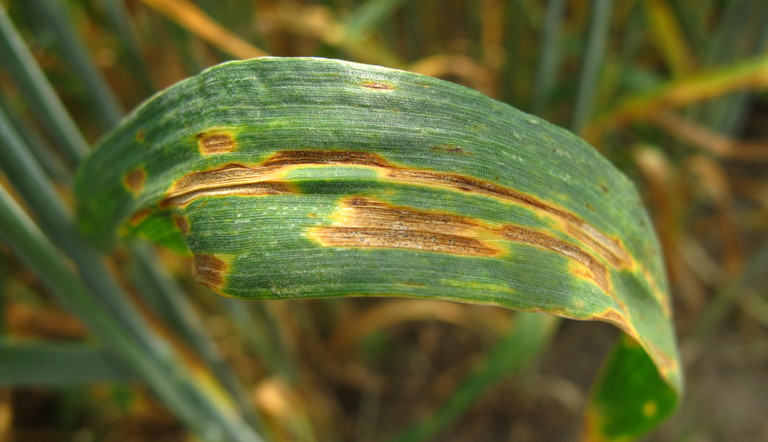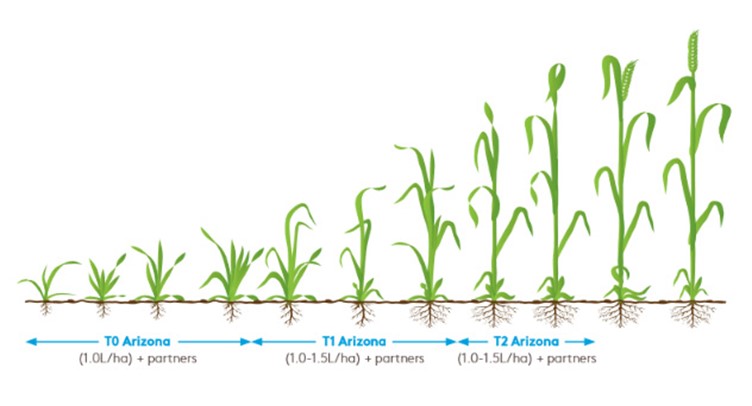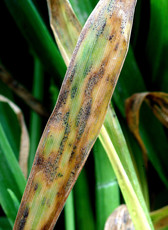
Don’t forget the folpet at T1

That could be particularly useful this year, not least because many crops – especially those which didn’t receive a T0 fungicide – are currently carrying high levels of active septoria. These crops will therefore require a robust treatment at T1, with the inclusion of ARIZONA (500 g/l folpet) adding a useful extra layer of protection.
With an Integrated Pest Management (IPM) programme in place to minimise the risks associated with cereal diseases such as septoria (burying/removing the previous crop’s trash, eliminating green bridges, not drilling too early and growing a resistant variety) the most effective way to control foliar diseases is via the implementation of a preventative fungicide strategy to keep crops ahead of infection.
The emphasis here is very much on prevention rather cure, as the current range of fungicide active ingredients (with the exception of anything containing Revysol or Inatreq) has limited curative capacity.
Preventing septoria from taking hold in wheat is best achieved by applying a diverse range of fungicide modes of action, with a multi-site such as ARIZONA (500 g/l folpet) included at T1 to add an extra layer of early season disease control.
Including folpet at T1 can deliver a significant yield improvement, with data from 29 trials conducted over a period of four years showing that a single application of ARIZONA at T1 will more than pay for itself by giving an average yield uplift of 0.26 t/ha. This makes the inclusion of folpet a cost-effective way of powering up fungicide programmes, with the latest data (from 54 trials over four years) suggesting that every Pound spent on folpet will deliver a five to six-fold return on investment (based on a wheat price of £220 per tonne).

In high-risk situations (for example where a susceptible wheat variety was drilled early and where wet conditions have exacerbated the disease loading) folpet can also be applied at T0 and again at T1 and T2 to provide season-long protection. In other situations, two applications (at T1 and T2) have been proven to increase the yield response to as much as +0.6t/ha when used alongside older azole/SDHI mixtures and by a more modest but still respectable 0.2 to 0.25 t/ha when used in conjunction with newer more effective single site actives such as Revysol and Inatreq.
Future-proofing septoria control
As well as the economic and yield benefit effects associated with using folpet at T1, ARIZONA’s multi-site mode of action also plays an important part in managing resistance: repeatedly using at risk single site fungicides (such as azoles, SDHIs, QiI’s and strobilurins) can increase the rate at which disease resistance to these active ingredients develops. However, the inclusion of folpet (which is less prone to resistance due to its ability to work against multiple metabolic processes within the target pathogen) can counter the reduction in sensitivity to single sites, with modelling studies carried out by ADAS/Rothamsted Research predicting that mixing a triazole with folpet can double the former’s effective life.
More recent modelling work carried out by ADAS (2019) also predicted that folpet can double the effective life of fluxapyroxad and that mixing folpet with field rates of fluxapyroxad delivers improved disease control.
The latest modelling work carried out by ADAS indicates that the inclusion of folpet can substantially extend the effective life of treatment programmes involving mixtures of ‘at risk’ single site products. Tank mixing folpet with appropriate doses of ‘at risk’ products helps slow down resistance development by reducing selection for less sensitive strains but also helps maintain disease control as resistance frequencies increase.
A valuable tool
Folpet is therefore recognised by the Fungicide Resistance Action Group (FRAG) as a valuable tool for managing resistance thanks to its ability not only to provide added levels of disease control, but also to protect and prolong the lifespan of medium to high resistance risk fungicides like SDHIs. For more information visit The Fungicide Resistance Action Group (FRAG-UK) website.
![Focal Point Preview: Product feature - Desktop[280x404]](https://www.adama.com/uk/sites/adama_uk/files/styles/product_feature_desktop/public/2023-03/ARIZONA-packshot.png?h=1af3c093&itok=3zofv7RN&focal_point_preview_value=50x50)
ARIZONA® (500 g/L folpet) is the ideal multi-site fungicide for septoria control: its ability to control septoria and deliver a positive yield response makes it a very cost-effective addition to T1 applications. It also provides the added benefits of extending the effective life of partner products and not interfering with the curative kickback activity of partner azoles or SDHIs.

Folpet delivers proven protection against septoria in wheat, with the latest trials showing that for every Pound spent, growers can expect to see a five to six-fold return on investment through improved yields.

ARIZONA is powered by ADAMA’s MSI (Multi-Site Inhibitor) Protech technology: as a multi-site inhibitor it works against various bio-chemical pathways within fungal cells (interfering with spore germination, cell division and mitochondrial energy production) which makes it less susceptible to resistance compared to single site actives.


